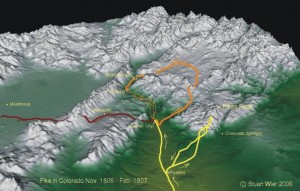Review by Ed Quillen
Zebulon Pike – March 2007 – Colorado Central Magazine
Zebulon Montgomery Pike’s – Great Western Adventure 1806-07
by Jack Kyle Cooper
Illustrated by Jon MacManus
Published in 2007 by Clausen Books
ISBN 0978704614
THIS BOOK PROVIDES an excellent overall picture of the Pike expedition and how it fit into the larger flow of American history during President Thomas Jefferson’s second term. Great Western Adventure is also quite informative on the details of the party’s visit to Colorado — how camps were organized, various duties of the soldiers, what arms they carried, etc.
But its fundamental premise seems flawed to me. When I read Pike’s journal, I get the idea that he truly was lost. I accept Pike’s account, which indicates that he thought he was on the Red River when he relaxed on the west bank of the Arkansas River on Christmas Day, 1806, and that after learning the truth he struck out southwest, and believed he was on the Red in January of 1807 when he built a stockade on Rio Grande drainage in the San Luis Valley. I’m willing to take Pike at his word.
Cooper tries to make the case that Pike knew where he was the whole time. The argument starts with Gen. James Wilkinson, Pike’s commander, noted for “never having won a battle nor lost a court-martial.”
According to Cooper, for whatever reasons (American border security, launching a private invasion with Aaron Burr, etc.), Wilkinson wanted Pike to reconnoiter the Spanish presence in New Mexico to determine the sites of towns and forts, the military forces and equipment, the morale of the population, etc.
But the Spanish would be patrolling the sensible routes to Santa Fé from the east, like Glorieta Pass or Sangre de Cristo Pass. The patrols would turn Pike back long before he got close enough to see anything of this “hidden kingdom” in the Rocky Mountains.
That’s what happened to the Freeman-Custis Expedition of 1806, which was supposed to ascend the Red River (then believed to start on the eastern slope of the Rocky Mountains, somewhere between the head of the Arkansas and the head of the Rio Grande). That expedition was turned back by Spanish soldiers just after entering modern Texas — a long ways from Santa Fé.
So Pike was supposed to approach Santa Fé from the north, where the Spanish would not be expecting visitors. Although Pike would likely be noticed before he got to Santa Fé , by then he’d be so close that the Spanish would have to take him there.
Military courtesy would insure his eventual release, and in the meantime, he could take careful notice of Spain’s forces at the north end of its empire.
As Cooper sees it, that’s what Wilkinson really wanted Pike to do, and Pike succeeded brilliantly. All the stuff that Pike wrote down about thinking he was on the Red was just a ruse so he’d have an excuse if the Spanish captured him. In Cooper’s view, Pike had secret “verbal orders” from Wilkinson.
But how well does this theory fit with Pike’s course through Central Colorado? In early December, 1806, Pike is camped at the mouth of the Royal Gorge. He writes that he believes the source of the Arkansas is within the great canyon before him. And so, why doesn’t he march southwest up Grape Creek, so that he can cross the Sangre de Cristo range and get to the Rio Grande to be captured by the Spanish? Why, if he knew where he was and where the rivers ran, did he attempt another fork of the Arkansas, get surprised to find the South Platte River, and then cross Trout Creek Pass back to the Arkansas?
And if he knew he was on the Arkansas when he was marching near Salida at the end of 1806, why didn’t he try to head south, to either the Rio Grande or the Red? Poncha Pass was right in front of him, a relatively easy route south. (And it’s interesting to speculate how much more pleasant that winter might have been if he had camped at the hot springs).
AS THE EXPEDITION’S TREK down the Arkansas canyon got harder, Pike even speculated that there were Indian or game trails over the side ridges. But he didn’t look for those routes because he thought he was on the Red River, and thus all he had to do was follow it down to civilization. Had he known he was on the Arkansas then, wouldn’t he have looked for a route south like Poncha Pass, especially if he had those “verbal orders” from Wilkinson to get down to the Rio Grande and Santa Fé?
As I read the journal, Pike was lost. If he wasn’t lost, then he put his men through a needless and terrible ordeal, since there were certainly easier ways, ways that an unlost leader would find, to approach Santa Fé from the north. And that requires believing that Pike was not merely headstrong and ambitious, but flat-out evil.
That said, I was impressed by much of the rest of the book. It reads pretty well, it has copies of old maps that are hard to find elsewhere, and it provides portraits of some participants. It is amply foot-noted with a copious list of sources. Great Western Adventure goes into considerable detail about the hard-working $5-a-month foot soldiers, who often get neglected in the Pike story.
So it’s a good source for additional information about the Pike expedition, even if its main argument, to me and many others, is fundamentally flawed. Cooper tells the story, but he doesn’t make his case.

